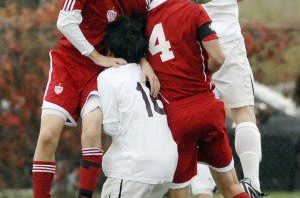As a former soccer player who has suffered three in-game concussions, I’ve often wondered about the effects that “routine” headers have on the brain. When I played as a defender, I sometimes took 15 to 20 headers per game off of goal kicks. Most times, these balls would plummet from high in the sky and if I didn’t hit them just right, I experienced a stinging sensation that occasionally resulted in short headaches. Despite the fact that my concussions were a result of head to head collisions and not common headers, I’ve been more interested in what these sub-concussive and repeated hits to the head can do to the brain. Ultimately, if these routine headers are affecting the brain, steps must be taken to improve player safety.
In October of 2016, a study about cognitive and electrical changes in the brain following routine headers was published in EBioMedicine. Presently, it is undeniable that soccer has detrimental effects of the brain, as studies have shown microstructural changes in white matter as well as cortical thinning in former professional soccer players aged 40 to 65. Yet, less is known about the effects of sub-concussive and repetitive hits in soccer.
The research group from Scotland used transcranial magnetic stimulation (TMS) to study a common marker for concussion called corticomotor inhibition, which manifests as a silent period in the signal from the instrument. The TMS findings ultimately indicate electrophysiological changes in the brain after hits to the head.
Additionally, the team used the Cambridge Neuropsychological Test Automated Battery (CANTAB) to assess cognitive changes in the brain. Within this computer-based test, the researchers could study reaction time, spatial working memory, attention switching, and rapid visual processing.
Twenty-three healthy amateur soccer players between the ages of 19 and 25 were recruited for the study. They excluded participants who had a previous brain injury involving loss of consciousness and a history of concussion in the past 12 months. The individuals were then given a series of baseline tests before moving onto the “heading” protocol.
This protocol involved heading a standard soccer ball twenty times over a 10-minute period. The balls were launched from a machine 6 meters away at roughly 24 miles per hour. They used a custom built accelerometer on the back of the participant’s head to measure the g-force from the impacts. The participants then repeated the baseline tests immediately after the activity and three more times at 24 and 48 hours, and finally at 14 days post activity.
They discovered increasing lengths of silent signals in the TMS, which indicated mildly significant increases in the corticomotor inhibition immediately after the activity. There was no significance at any other time points, however. They also observed higher error scores in spatial working memory cognitive test immediately after the activity, which was indicative of impairments in short-term memory. Additionally, they observed higher error in tests of long-term memory function immediately following activity. While no other cognitive tasks had significantly different results, the study did provide evidence of transient disturbances in both short and long-term memory. Even though the impairments from the sub-concussive impacts didn’t ever persist for a full day, these results represent the first evidence that headers immediately affect the brain.
The research team believes that increases in silent periods could be linked to increased GABA inhibitory activity, which might be a mechanism for the body to protect itself against minor injury. The increased corticomotor inhibition, however, has previously been associated with pathophysiology in brain damage and suggests a link between functional issues in the brain and overactive inhibitory neurons.
While the study is far from perfect in terms of design and significance of results, it hints at immediate brain changes that cannot be taken lightly. Further studies into the effects of sub-concussive hits in soccer, i.e., routine headers, must be undertaken. The specific types of headers and the actions that contribute to these changes should be studied in order to improve education on safe heading practices. Additionally, studies should look into the effectiveness of “soft” helmets that are becoming more common in soccer.
New Evidence Shows Immediate Effects of Soccer Headers
